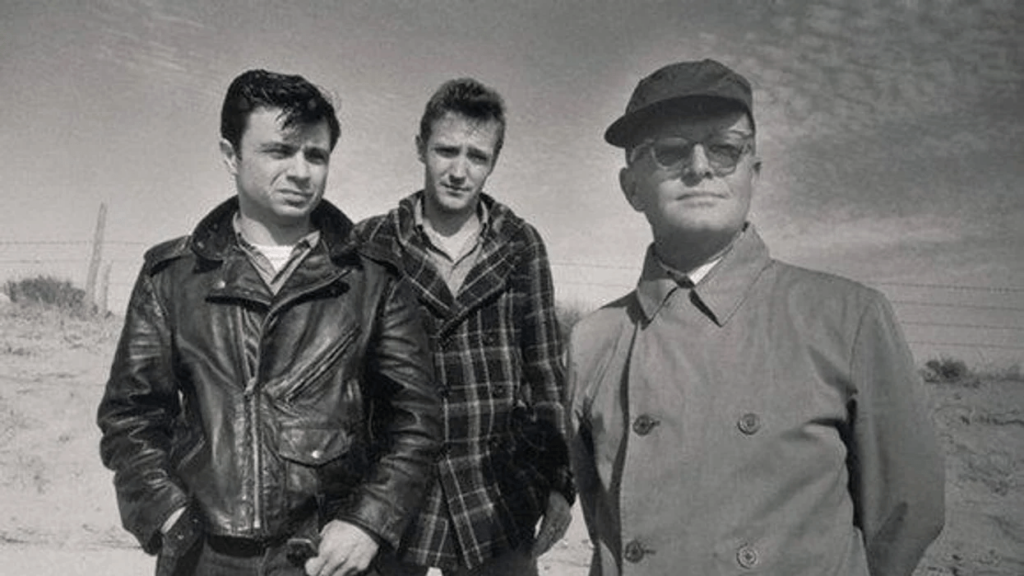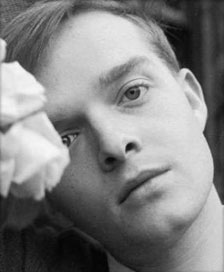Ghosts In Sunlight. The Filming Of In Cold Blood, Truman Capote

GHOSTS IN SUNLIGHT. THE FILMING OF IN COLD BLOOD
One hot afternoon last March in a courthouse on the high wheat plains of western Kansas, Richard Brooks turned to me, between takes of the movie he was directing, and rather reproachfully asked, “What are you laughing at?”
“Oh, nothing,” I said, but the truth was that I’d remembered a long-ago question by Perry Smith, one of the two murderers whose trial was being reenacted here. He had been captured a few days before, and his question was, “Were there any representatives of the cinema there?”
I wondered what he would have thought of the present scene: the huge arc lights arranged inside the courtroom where he and Richard Hickock had been tried, the jury box filled with the very same men who had convicted them, the purring generators, whirring cameras, the whispering technicians dancing in and out among thick coils of electric cable.
The first conversation I ever had with Perry Smith was at the beginning of January, 1960. It was a cold day, glittery as an icicle; Smith and I talked together at the sheriff’s office in a room where prairie winds pressed against the windows, sucked the glass, rattled it.
I was fairly rattled myself, for I had been working for more than a month on a book about the murder of Herbert Clutter and his family, In Cold Blood, and unless I could establish close contact with this half-Irish, half-Indian young man, I would have to abandon the project. His court-appointed attorney had persuaded him to speak to me; but it was soon obvious that Smith regretted having granted the interview. He was remote, suspicious, sullenly sleepy-eyed: It took years, hundreds of letters and conversations, before I slipped all the way past this façade.
At the moment, nothing I said interested him. He rather arrogantly began to question my credentials. What kind of writer was I, and what had I written? Well, he said, after I’d provided a dossier, he’d never heard of me or any of my books; but—had I written any movies? Yes, one: Beat the Devil. Now the sleepy eyes somewhat wakened. “Uh-huh. I remember. Only saw it because Humphrey Bogart was in it. Did you, uh, uh, know Bogart? Personally?”
When I answered that Bogart had been a close friend of mine, he smiled in the flustered, fragile way I came to know very well. “Bogart,” he said, his voice so soft one could scarcely hear it above the wind. “I’ve always had this thing about him. He was my favorite actor. I saw Treasure of the Sierra Madre—oh, over and over. One of the reasons I liked that picture so much was—the old man in it, Walter Huston? that played the crazy gold prospector?—he was just like my father. Tex Smith. Just like him. I couldn’t get over it. It really hit me.” Then he said, “Were you there last night? When they brought us in?”
He was referring to the previous evening when the two handcuffed murderers, escorted by a regiment of state troopers, had arrived by car from Las Vegas, where they were arrested, to be arraigned at the Finney County courthouse in Garden City, Kansas. Hundreds of people had waited for hours in the dark and zero-cold to glimpse them; the crowd, orderly, almost awesomely hushed, had filled the square. The press, too, had been heavily represented by newsmen from all over the West and Midwest; there were also several television crews.
I told him yes, I’d been present—and had minor pneumonia to prove it. Well, he said, he was sorry about that: “Pneumonia is nothing to fool around with. But tell me—I was so scared I couldn’t see what was happening. When I saw that crowd, I thought, Jesus, these people are going to tear us limb from limb.
To hell with the public hangman. They were going to hang us on the spot. Which maybe wouldn’t have been the worst idea. I mean, what’s the use of going through this whole ordeal? Trial and everything. It’s such a farce. These prairie-billies, they’ll hang us in the long run.” He chewed his lip; something shy and bashful happened to his face—the aw-gee expression of a kid digging his toe into the ground. “What I wanted to know is—were there any representatives of the cinema there?”
This was typical of Perry—of his pathetic linguistic pretensions (the careful insertion of words like “cinema”), and of the kind of vanity that made him welcome “recognition” regardless of its nature. He tried to disguise it, shrug it off, but nevertheless he was undeniably gratified when I informed him that indeed the event had been recorded by motion-picture cameras.
Now, seven years later, I laughed to myself at the recollection, but I avoided answering Brooks’s query because the young men who were playing Perry and Dick were standing nearby, and I felt extremely uneasy in their presence. Self-conscious. I had seen photographs of Robert Blake (Perry) and Scott Wilson (Dick) before they were selected for the roles.
But it wasn’t until I went to Kansas to follow the progress of the film that I met them. And meeting them, having to be around them, was not an experience I care to repeat. This has nothing to do with my reaction to them as private individuals: they both are sensitive, seriously gifted men. It’s simply that despite the clear physical resemblance to the original pair, their photographs had not prepared me for the mesmerizing reality.
Particularly Robert Blake. The first time I saw him I thought a ghost had sauntered in out of the sunshine, slippery-haired and sleepy-eyed. I couldn’t accept the idea that this was someone pretending to be Perry, he was Perry—and the sensation I felt was like a free fall down an elevator shaft. Here were the familiar eyes, placed in a familiar face, examining me with the detachment of a stranger.
It was as though Perry had been resurrected but was suffering from amnesia and remembered me not at all. Shock, frustration, helplessness—these emotions, combined with impending flu, sent me home to a motel on the outskirts of Garden City. The Wheat Lands Motel, a place I had often stayed during the years I worked on In Cold Blood. An accumulated remembrance of those years, the loneliness of the endless wintry nights with forlorn salesmen coughing next door, seized me like a sudden Kansas cyclone and threw me on the bed.
To quote from my day-to-day journal: “Presently passed out, having drunk a pint of Scotch in less than thirty minutes. Woke in the morning with fever, television still going and total lack of knowledge of where I was or why. All unreal because too real, as reality’s reflections tend to be. Called Dr. Maxfield, who gave me an injection and several prescriptions. But the trouble is in my mind (?).”
That phrase “reality’s reflections” is self-explanatory, but perhaps I ought to clarify my own interpretation of it. Reflected reality is the essence of reality, the truer truth. When I was a child I played a pictorial game. I would, for example, observe a landscape: trees and clouds and horses wandering in grass; then select a detail from the overall vision—say, grass bending in the breeze—and frame it with my hands.
Now this detail became the essence of the landscape and caught, in prismatic miniature, the true atmosphere of a panorama too sizable to encompass otherwise. Or if I was in a strange room, and wanted to understand the room and the nature of its inhabitants, I let my eye wander selectively until it discovered something—a shaft of light, a decrepit piano, a pattern in the rug—that seemed of itself to contain the secret. All art is composed of selected detail, either imaginary or, as in In Cold Blood, a distillation of reality. As with the book, so with the film—except that I had chosen my details from life, while Brooks had distilled his from my book: reality twice transposed, and all the truer for it.
As soon as the book was published, many producers and directors expressed a desire to make a film of it. Actually, I had already decided that if a film was to be made, I wanted the writer-director Richard Brooks to act as intermediary between book and screen. Aside from my long-standing respect for his imaginative professionalism, he was the only director who agreed with—and was willing to risk—my own concept of how the book should be transferred to film. He was the one person who entirely accepted two important points: I wanted the film made in black and white, and I wanted it played by a cast of unknowns—that is, actors without “public” faces.
Although Brooks and I have different sensibilities, we both wanted the film to duplicate reality, to have the actors resemble their prototypes as much as possible, and to have every scene filmed in its real locale: the house of the murdered Clutter family; the same Kansas variety store where Perry and Dick bought the rope and tape used to bind their four victims; and certain courthouses, prisons, filling stations, hotel rooms and highways and city streets—all those places that they had seen in the course of their crime and its aftermath. A complicated procedure, but the only possible one by which almost all elements of fantasy could be removed and reality thereby achieve its proper reflection.
I felt this particularly strongly when Brooks and I went into the Clutter house while Brooks was preparing to film the murder sequence. To quote from my
